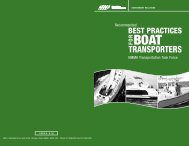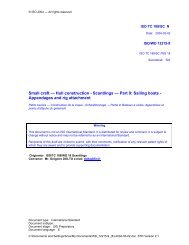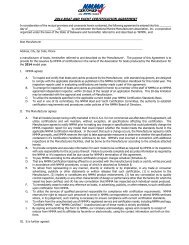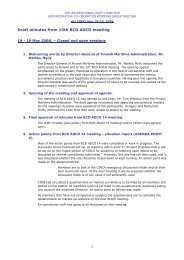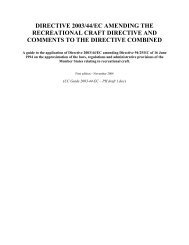global environmental legislation guide - National Marine ...
global environmental legislation guide - National Marine ...
global environmental legislation guide - National Marine ...
You also want an ePaper? Increase the reach of your titles
YUMPU automatically turns print PDFs into web optimized ePapers that Google loves.
io fouling can also be a significant vector for the transfer of invasive aquatic species. Biofouling on ships entering the waters of states may result in the establishment of invasiveaquatic species which may pose threats to human, animal and plant life, economic andcultural activities and the aquatic environment.While the international convention on the control of harmful anti-fouling systems on ships,2001 (AFS convention) addresses anti-fouling systems on ships, its focus is on the preventionof adverse impacts from the use of anti-fouling systems and the biocides they may contain,rather than preventing the transfer of invasive aquatic species.The potential for invasive aquatic species transferred through bio fouling to cause harm hasbeen recognized by the IMO, the Convention on Biological Diversity (CBD), several UNEPregional seas convention, e.g. Barcelona Convention for the Protection of theMediterranean Sea against Pollution, the Asia Pacific Economic Cooperation forum (APEC),and the Secretariat of the Pacific Region Environmental Program (SPREP).IMO Bio fouling <strong>guide</strong>lines adoptedIMO – MEPC adopted the first set of international recommendations to address bio foulingof ships in order to minimise the transfer of aquatic species.Studies have shown that the bio fouling process begins within the first few hours of a ship’simmersion in water. The bio fouling that may be found on a ship is influenced by a range offactors:• design and construction, particularly the number, location and design of niche areas;• specific operating profile, including factors such as operating speeds, ratio of timeunderway compared with time alongside, moored or at anchor, and where the ship islocated when it is not in use (e.g. open anchorage or estuarine port);• places/ports visited and navigation routes;• maintenance history, including: the type, age and condition of any anti-fouling coatingsystem, installation and operation of anti-fouling systems and dry-docking/slipping andhull cleaning practicesImplementing practices to control and manage bio fouling can assist in reducing the risk ofthe transfer of invasive aquatic species. Such management practices can also improve aship’s hydrodynamic performance and can be effective tools in enhancing energy efficiencyand reducing air emissions from ships. This concept has been identified by the IMO in the‘Guidance for the development of a ship energy efficiency management plan’.Guidelines objectives:The objectives of these <strong>guide</strong>lines are to provide practical guidance to states, shipmasters,operators and others on measures to minimize the risk of transferring invasive aquaticspecies from ships’ bio fouling. It is important for bio fouling management procedures to beeffective as well as <strong>environmental</strong>ly safe, practicable, designed to minimise costs and delaysto the ship, and based upon these <strong>guide</strong>lines whenever possible.Implementation and management35



